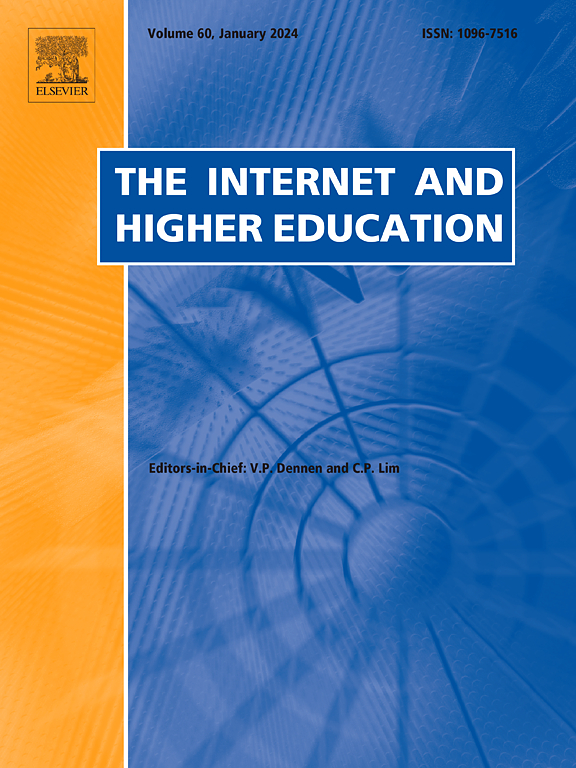Can theory-driven learning analytics dashboard enhance human-AI collaboration in writing learning? Insights from an empirical experiment
IF 6.8
1区 教育学
Q1 EDUCATION & EDUCATIONAL RESEARCH
引用次数: 0
Abstract
The integration of Generative AI (GenAI) into education has raised concerns about over-reliance and superficial learning, particularly in writing tasks in higher education. This study explores whether a theory-driven learning analytics dashboard (LAD) can enhance human-AI collaboration in the academic writing task by improving writing knowledge gains, fostering self-regulated learning (SRL) skills and shaping different human-AI dialogue characteristics. Grounded in Zimmerman's SRL framework, the LAD provided real-time feedback on learners' goal-setting, writing processes and reflection, while monitoring the quality of learner-AI interactions. A quasi-experiment was conducted involving 52 postgraduate students in a human-AI collaborative writing task. The students were divided into an experimental group (EG) that used the LAD and a control group (CG) that did not. Pre- and post- knowledge tests, questionnaires measuring SRL and cognitive load, and students' dialogue data with GenAI were collected and analyzed. Results showed that the EG achieved significantly higher writing knowledge gains and improved SRL skills, particularly in self-efficacy and cognitive strategies. However, the EG also reported increased test anxiety and cognitive load, possibly due to heightened metacognitive awareness. Epistemic Network Analysis revealed that the EG engaged in more reflective, evaluative interactions with GenAI, while the CG focused on more transactional and information-seeking exchanges. These findings contribute to the growing body of literature on the educational use of GenAI and highlight the importance of designing interventions that complement GenAI tools, ensuring that technology enhances rather than undermines the learning process.
理论驱动的学习分析仪表板能否增强人类与人工智能在写作学习中的协作?来自经验实验的见解
将生成式人工智能(GenAI)整合到教育中,引起了人们对过度依赖和肤浅学习的担忧,特别是在高等教育的写作任务中。本研究探讨了理论驱动的学习分析仪表板(LAD)是否可以通过提高写作知识获取、培养自我调节学习(SRL)技能和塑造不同的人类与人工智能对话特征,来增强学术写作任务中的人类与人工智能协作。基于Zimmerman的SRL框架,LAD对学习者的目标设定、写作过程和反思提供实时反馈,同时监控学习者与人工智能互动的质量。我们对52名研究生进行了一项准实验,让他们参与人类与人工智能的协作写作任务。学生被分为实验组(EG)使用LAD和对照组(CG)不使用。收集和分析了知识前后测试、测量SRL和认知负荷的问卷以及学生与GenAI的对话数据。结果表明,EG显著提高了学生的写作知识增益,提高了学生的SRL技能,尤其是在自我效能感和认知策略方面。然而,EG也报告了考试焦虑和认知负荷的增加,可能是由于元认知意识的增强。认知网络分析显示,EG与GenAI进行更多的反思性、评价性互动,而CG则侧重于更多的交易性和信息寻求性交流。这些发现促进了越来越多关于GenAI在教育中的应用的文献,并强调了设计干预措施以补充GenAI工具的重要性,确保技术增强而不是破坏学习过程。
本文章由计算机程序翻译,如有差异,请以英文原文为准。
求助全文
约1分钟内获得全文
求助全文
来源期刊

Internet and Higher Education
EDUCATION & EDUCATIONAL RESEARCH-
CiteScore
19.30
自引率
4.70%
发文量
30
审稿时长
40 days
期刊介绍:
The Internet and Higher Education is a quarterly peer-reviewed journal focused on contemporary issues and future trends in online learning, teaching, and administration within post-secondary education. It welcomes contributions from diverse academic disciplines worldwide and provides a platform for theory papers, research studies, critical essays, editorials, reviews, case studies, and social commentary.
 求助内容:
求助内容: 应助结果提醒方式:
应助结果提醒方式:


